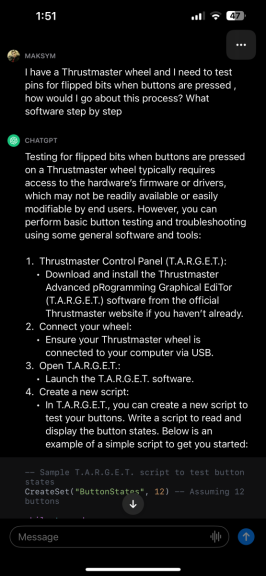- 239
I’m using Thrustmaster wheels for years. Until recently on a T300 wheelbase, but now I have moved on to a Virtual Racing School DirectForce Pro direct drive wheelbase. A direct drive wheelbase is quite an expense, I did not want to buy new wheels as well. Since I had already added a quick release to my Thrustmaster wheels I was looking for a way to reuse these on the VRS DirectForce Pro, with working buttons. A few guys figured out parts of my project:
- Peter Makes Things made an excellent quick release for Thrustmaster wheels. Available here: https://kapral.store/collections/pmt-peter-make-things
- Ultrawipf made a Thrustmaster quick release compatible wheel mount for direct drive wheels with servo or stepper motors with keyways, available on Thingiverse: https://www.thingiverse.com/thing:4379504
- RamjetX made a lock ring (a big nut): https://www.thingiverse.com/thing:3117355
- You need a 22 mm bore Quick Disconnect JA bushing (bolts and rings are included): https://nl.aliexpress.com/item/32579638637.html (add “22 mm bore” in the remarks when ordering)
- Someone on Aliexpress found out a 34,9 mm bicycle seat pin clamp fits this QD JA bushing perfectly: https://www.internet-bikes.com/102476-m-wave-zadelpenklem-349-mm-zwart/
- Taras figured out how to read the buttons of a Thrustmaster wheel using an Arduino Uno: https://rr-m.org/blog/hacking-a-thrustmaster-tx-rw-gaming-wheel-with-arduino-uno-part-1/
- Noel McCullagh converted Taras’ project to a Sparkfun Pro Micro board: https://www.noelmccullagh.com/
- Figuring out how to connect the Sparkfun Pro Micro to a female 6 pin mini-DIN connector.
- Enhanced Noel’s Arduino code by adding support for hot plugging Thrustmaster R383, F1 and Ferrari 599xx Evo wheels. It detects which wheel is plugged in and maps the corresponding buttons.
- Added support for the Thrustmaster F1 wheel. This took me a few days since I had a lot of timing issues with this wheel. Maybe Thrustmaster is using different chips inside the wheel, I don’t know, but I managed to solve it in the end.
- Converting all button numbers on these wheels to the standard Thrustmaster button numbering, this makes swapping wheels easier. All buttons are working on the wheels mentioned.
Rename TMwheels.ino.txt to TMwheels.ino.
March 21 2022: manual updated to version 1.1, see first post below.
June 2022: addendum - alternative to the 3D printed steering shaft, see post #3 below.
October 2022: tiny bug fixed in the Arduino code, 'button pressed' was sent continuously over USB as long as a button was pressed (sending 'button pressed' once is enough).
November 2023: if you experience a bit of play in the wheel or hear clicks while turning the wheel at high FFB forces, see this post how to fix that.
Have fun!
Insert Coin
Attachments
Last edited:


 would be crazy to add SF100 to all those who switched to DD
would be crazy to add SF100 to all those who switched to DD 
